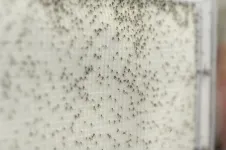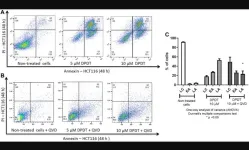(Press-News.org) Researchers at the University of California San Diego School of Medicine have led a study to examine a potential new treatment option for patients with nonalcoholic steatohepatitis (NASH)-related fibrosis.
The results, published in the June 24, 2023, online edition of The New England Journal of Medicine, found that a drug that mimics a hormone in the body improved both liver fibrosis, or scarring of the liver, and liver inflammation in patients with NASH.
“Identifying an effective drug for NASH is extremely promising for patients as currently there are no FDA-approved therapies for this condition,” said Rohit Loomba, MD, the study’s first author and chief of the Division of Gastroenterology and Hepatology at UC San Diego School of Medicine. “NASH can adversely impact the quality of life in patients and can progress to cirrhosis. Its complications can lead to death or liver transplantation.”
“Our findings will further the science of this disease and provide a potential new treatment option to those affected by NASH-related fibrosis.”
The researchers found that the drug, called Pegozafermin, mimicked fibroblast growth factor 21 (FGF21) — a liver-secreted peptide hormone that is naturally produced in the body.
FGF21 controls energy use in the body and lipid metabolism in the liver. It has also been shown in previous studies to lower blood glucose and insulin levels, reducing body weight and liver fat.
“The study’s results show that the new potential treatment not only improves fibrosis but also improves inflammation and liver injury along with significant improvements across multiple non-invasive biomarkers of NASH activity and scarring,” said Loomba, gastroenterologist and hepatologist at UC San Diego Health.
The 24-week, randomized clinical trial involved 222 participants with NASH assigned to either receive the drug or a placebo.
Of the patients who received the drug at a higher dose, approximately 27% showed an improvement in liver fibrosis, relative to 7% of the patients who received the placebo. The most frequent reported side effect from the drug were gastrointestinal in nature, including nausea.
Currently, there are no medications approved by the U.S. Food and Drug Administration available for the treatment of NASH, which is a type of nonalcoholic fatty liver disease (NAFLD).
According to the National Institutes of Health, approximately 24% of U.S. adults have NAFLD, and about 6% have NASH.
NAFLD and NASH are considered silent diseases with little to no symptoms; however, individuals who are overweight, have type 2 diabetes or have a family member with NAFLD are at a higher risk of developing the disease. NAFLD — which is an umbrella term for a range of liver conditions affecting people who drink little to no alcohol — can lead to cirrhosis, liver cancer and liver failure.
Loomba adds next steps for this research will be a larger, multi-center, international trial with a more diverse patient population and longer treatment period to better assess the safety of the drug.
“If successfully shown to be both safe and effective in a larger Phase 3 trial, this drug could be used to treat millions of patients with NASH, including our patients at UC San Diego Health,” said Loomba.
Co-authors of the study include: Arun J. Sanyal, MD, Virgina Commonwealth University; Kris V. Kowdley, MD, Washington State University; Deepak L. Bhatt, MD, MPH, Mount Sinai Heart; Naim Alkhouri, MD, Arizona Liver Health; Juan Pablo Frias, MD, Velocity Clinical Research; Pierre Bedossa, MD, PhD, University of Oxford; Stephen A. Harrison, MD, Pinnacle Clinical Research; Donald Lazas, MD, Objective Health; Robert Barish, MD, Ocala GI Research; Mildred D. Gottwald, Pharm.D, Shibao Feng, PhD, Germaine D. Agollah, PhD, Cynthia L. Hartsfield, PhD, Hank Mansbach, MD, Maya Margalit, MD, all at 89bio; and Manal F. Abdelmalek, MD, MPH, Mayo Clinic.
# # #
END
Study: Potential new treatment identified for liver disease
In a nationwide, multi-center clinical trial, researchers identified a potential new drug that improved liver fibrosis in patients with NASH by 27%
2023-06-26
ELSE PRESS RELEASES FROM THIS DATE:
Best papers of 2022 announced by SPIE Journal of Applied Remote Sensing
2023-06-26
BELLINGHAM, Washington, USA — The Journal of Applied Remote Sensing (JARS) has honored four of its best papers published in 2022. The awards recognize the journal’s best student paper, as well as papers in interdisciplinary applications, theoretical innovation, and photo-optical instrumentation and design.
JARS is published online in the SPIE Digital Library by SPIE, the international society for optics and photonics, and optimizes the communication of concepts, information, and progress among the remote-sensing ...
Study finds human impact on wildlife even in protected areas
2023-06-26
HOUSTON – (June 26, 2023) – By 2030, if the 30 by 30 initiative supported by more than 100 countries is successful, 30% of our land and ocean ecosystems will be designated protected areas meant to safeguard biodiversity and help limit the impacts of climate change.
However, a study by Rice University ecologist Lydia Beaudrot and collaborators reports for the first time that tropical mammals living inside protected areas are not spared the effects of human activity even when it occurs outside of the protected boundaries.
Based on the ...
University of Oklahoma researcher to use NSF CAREER Award to study local community's disaster resilience
2023-06-26
University of Oklahoma assistant professor Xiaochen (Angela) Zhang, Ph.D., has received a prestigious Faculty Early Career Development Award, known as a CAREER award, from the National Science Foundation to study how relationships among non-profits, community groups and local government agencies can improve disaster resilience, resource allocation, and emergency management by enabling organizational interactions, rather than top-down responses.
Zhang, who is an assistant professor of public relations for the Gaylord College ...
Research Brief: Investing in nature improves equity, boosts economy
2023-06-26
MINNEAPOLIS/ST. PAUL (06/26/2023) — A new study shows that current trends in environmental degradation will lead to large economic losses in the coming decades, hitting the poorest countries hardest. But there is hope: investing in nature can turn those losses into gains.
Researchers from the University of Minnesota and Purdue University published their findings in Proceedings of the National Academy of Sciences. The team developed a first-of-its-kind, global earth-economy model to capture interactions ...
New geochemistry research confirms megalodon shark was warm-blooded
2023-06-26
William Paterson University PRESS RELEASE
EMBARGOED UNTIL MONDAY, JUNE 26, 2023, 3:00 PM EST
WAYNE, NEW JERSEY — A new study shows that the gigantic Megalodon, or megatooth shark, was warm-blooded. This latest research on the Megalodon, which lived in the world’s oceans from 23 million to 3.6 million years ago and measured about 50 feet in length, appears in the peer-reviewed journal Proceedings of the National Academy of Sciences.
The study, conceived of and led by Michael Griffiths ...
Megalodon was no cold-blooded killer
2023-06-26
The largest marine predator that ever lived was no cold-blooded killer.
Well, a killer, yes. But a new analysis by environmental scientists from UCLA, UC Merced and William Paterson University sheds light on the warm-blooded animal’s ability to regulate its body temperature — and might help explain why it went extinct.
After analyzing isotopes in the tooth enamel of the ancient shark, which went extinct about 3.6 million years ago, the scientists concluded the megalodon could maintain a body temperature that was about ...
UCalgary study provides insight into how an infectious parasite uses immune cells as a Trojan Horse
2023-06-26
University of Calgary researchers have discovered how Leishmania parasites hide within the body to cause Leishmaniasis. The tiny parasites are carried by infected sand flies. Considered a tropical disease, one to two million people in more than 90 countries are infected every year. Effects range from disfiguring skin ulcers to enlarged spleen and liver and even death.
This chronic disease has been difficult to detect in the early stages. Scientists realized that the parasite was somehow manipulating immune cells but this process had not been well understood.
“This is the first study that shows how the parasite stalls the process of regular ...
Poop and prey help researchers estimate that gray whales off Oregon Coast consume millions of microparticles per day
2023-06-26
CORVALLIS, Ore. – Oregon State University researchers estimate that gray whales feeding off the Oregon Coast consume up to 21 million microparticles per day, a finding informed in part by poop from the whales.
Microparticle pollution includes microplastics and other human-sourced materials, including fibers from clothing. The finding, just published in the journal Frontiers in Marine Science, is important because these particles are increasing exponentially and predicted to continue doing so in the coming decades, according to researchers Leigh Torres and Susanne Brander.
Microparticle pollution is a threat to the health of ...
A smarter way to monitor critical care patients
2023-06-26
Surgical and intensive care patients face a higher risk of death and longer hospital stays because they are susceptible to both hypotension and hemodynamic instability – or unstable blood flow.
These potential complications require round-the-clock monitoring of several cardiac functions by nurses and physicians, but there’s currently no singular, convenient device on the market that can measure the most vital aspects of a patient’s cardiovascular health.
Ramakrishna Mukkamala, professor of bioengineering at the University of Pittsburgh Swanson School of Engineering, and Aman Mahajan, ...
DPDT anticancer activity in human colon cancer HCT116 cells
2023-06-26
“Altogether, our results show that DPDT preferentially targets HCT116 colon cancer cells likely through DNA topoisomerase I poisoning.”
BUFFALO, NY- June 26, 2023 – A new research paper was published in Oncotarget's Volume 14 on June 21, 2023, entitled, “Diphenyl ditelluride anticancer activity and DNA topoisomerase I poisoning in human colon cancer HCT116 cells.”
Diphenyl ditelluride (DPDT) is an organotellurium (OT) compound with pharmacological properties, including antioxidant, antigenotoxic and antimutagenic activities when applied at low concentrations. However, ...
LAST 30 PRESS RELEASES:
Chicago health information leader recognized for raising CPR readiness and blood pressure awareness
The Intimate Animal, a new book from Kinsey Institute Executive Director Dr. Justin Garcia
When blue-collar workers lose union protection, they try self-employment
New video dataset to advance AI for health care
MEA-based graph deviation network for early autism syndrome signatures in human forebrain organoids
New modeling approach sheds light on rare gut disease
Study documents potentially hazardous flame retardants in firefighter gear
Can certain bacteria regulate aging of the immune system and its related alterations?
AI model helps diagnose often undetected heart disease from simple EKG
There are fewer online trolls than people think
Cell membrane fluctuations produce electricity
Jeonbuk National University study shows positive parenting can protect adolescents against self-harm
Surface-engineered ZnO nanocrystals to tackle perfluoroalkyl substance contamination
This new understanding of T cell receptors may improve cancer immunotherapies
A new fossil face sheds light on early migrations of ancient human ancestor
A new immunotherapy approach could work for many types of cancer
A new way to diagnose deadly lung infections and save lives
40 percent of MRI signals do not correspond to actual brain activity
How brain-inspired algorithms could drive down AI energy costs
Gum disease may be linked to plaque buildup in arteries, higher risk of major CVD events
Contrails are a major driver of aviation’s climate impact
Structure of dopamine-releasing neurons relates to the type of circuits they form for smell-processing
Reducing social isolation protects the brain in later life
Keeping the heart healthy increases longevity even after cancer
Young adults commonly mix cannabis with nicotine and tobacco
Comprehensive review illuminates tau protein's dual nature in brain health, disease, and emerging psychiatric connections
Book prepares K-12 leaders for the next public health crisis
Storms in the Southern Ocean mitigates global warming
Seals on the move: Research reveals key data for offshore development and international ecology
Sports injuries sustained during your period might be more severe
[Press-News.org] Study: Potential new treatment identified for liver diseaseIn a nationwide, multi-center clinical trial, researchers identified a potential new drug that improved liver fibrosis in patients with NASH by 27%










